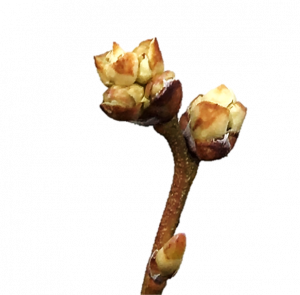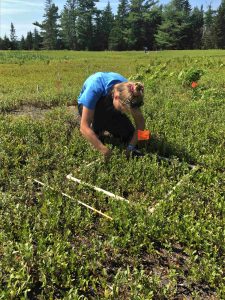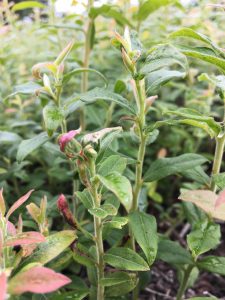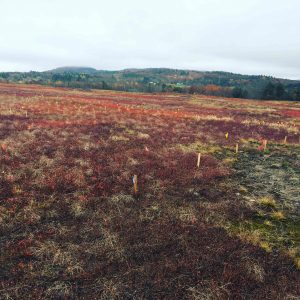Estimating Your Fruit Set
Why Should you Estimate your Fruit Set?
Estimating your percent fruit set is a good indicator of pollination, management and overall crop health. If you had good pollination but you have poor yield, other factors impacting fruit set can include: a poor prune the previous year leading to low flower density on stems, frost, drought, weeds, disease, and insect pests. In our field research, we use this measure to compare various treatments (for example, to monitor the yield improving effects of various field amendments). This is an effective way to broadly assess the efficacy of management methods (i.e. mulching, pruning, cultural management or chemical control) within you’re own field in a single year or from year to year to monitor changes in fruit set and subsequently improve management.
Calculating your fruit set accurately depends on the timing of your measurements relative to the plants phenology. Check out our Real-Time Phenology Tracker for current wild blueberry stages across the state and information on how to stage your own.
Calculating % Fruit Set
The most straightforward way to estimate potential yield is by estimating % fruit set. This is the percentage of flowers that become fruit. Total fruit set is a result of flowers pollinated throughout the entire bloom period where bees are active in your field.
Supplies required:
- 6-10 stakes at least 2 feet high and visible from a far (painted or marked with ribbon)
- a ball of string or ribbon, or a roll of fine wire.
- waterproof tags
- waterproof pen to mark on the tags
- clipboard, pad of paper, pencil, and magnifying glasses (optional)
Instructions:
- In early spring (end of April), go out into your crop field and select 6-10 clones, the more the better. Clones are genetically distinct blueberry plants. In crop fields they can be distinguished early in the season because they have differences in stem color, stem hairiness, leaf color and hairiness, and flower size and color (later during bloom). Mark the clones with a visible stake.
- At the time of “loose cluster” when most of the flower buds are separated from the bud clusters on a stem, tie a string, ribbon, or wire; loosely around the base of the stem. This loop of string or wire should also have a waterproof tag attached that has a unique number for the clone and stem. Select 3 arbitrary stems (if you select 10 clones) or 5 such stems (if you selected 6 clones) in each of your staked clones (Figure 1).
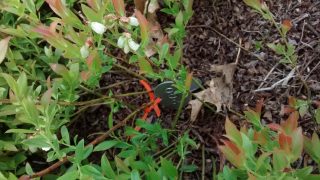
Figure 1. A tagged stem with a fine wire wrapped loosely around the stem. Photo credit: Elissa Ballman. - On your KNEES, count the number of flowers on each marked stem. Do this 3 times because mistakes are made when counting many flowers on a stem. Each time you count the flowers, write it down on a pad of paper. Once you have 3 numbers, calculate the average for that stem. Clones will mature into flowers at different times. Count flowers on a stem when they have separated so that you can count them individually. Come back to count later maturing stems. Once you have finished counting the flowers, put the pad with all your data in a safe place and wait until after bloom.
- Head out into the same field 10-14 days after bloom. By this time the flowers that were successfully pollinated will be swollen immature very small green fruit. Get your pad of paper and at each of your marked stems count the number of fruit. Make sure that you DO NOT count the pinheads. These are the flowers that never received enough compatible pollen and will not develop into fruit. They look like little green stars.
- After finishing your fruit counts, go and sit down, and get ready with your calculator or computer spreadsheet. For each stem in a clone calculate the percent fruit set:
% fruit set on a stem = (# fruit / # flowers )* 100
Once you have calculated all stem % fruit set calculations for a specific clone, calculate the average per clone. When you have an average % fruit set value for EACH clone, average the clone % fruit sets to get the average % fruit set over all your clones. This value is the average % fruit set for your field.
How do I interpret my estimated % fruit set of the field?
The rule of thumb is:
- greater than 70% is excellent fruit set
- 50-70% is good fruit set
- 25-50% is average fruit set
- below 25% is poor fruit set
Watch the fruit set video “How to Estimate Bee Abundance in Maine Blueberries” to answer any additional questions you may have. Finally, keep in mind that an estimate of % fruit set, while it is a good index of potential yield, it is not identical to your pollinator strength. For methods on estimating pollinator strength see “Estimation Your Pollinator Force“, section III.
Percent fruit set is affected by the number and activity of bees, yet it is also affected by the weather during bloom, and insect pests and diseases that might kill flowers during bloom. These factors are important to keep in mind as you take these measurements throughout your field. Perhaps, go a step further to compare and contrast sections of your field to investigate potential management and environmental impacts on fruit set.
Prepared by Frank Drummond, Professor Emeritus of Insect Ecology, University of Maine. May 2020.

